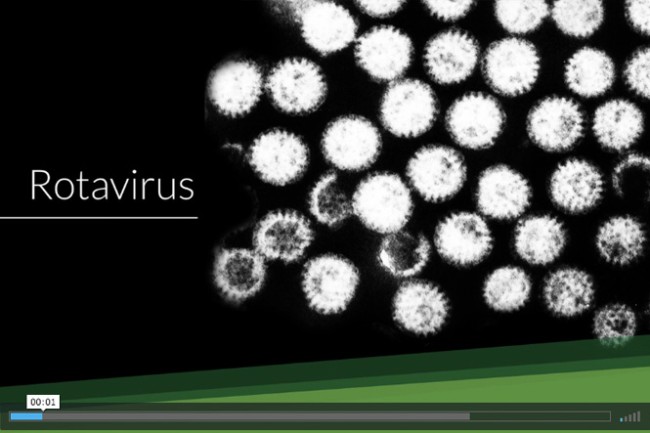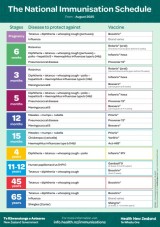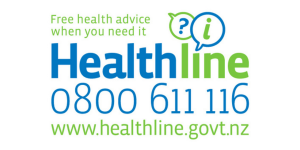Rotavirus
Commonly referred to as a tummy bug or stomach flu. Also known as gastroenteritis
Key points about rotavirus
- Rotavirus is a viral infection that causes fever, vomiting and diarrhoea, mostly in babies and young children.
- Vaccination against rotavirus is very effective in preventing infection and the serious complications it can cause.
- Thorough hand washing is also important to stop the spread of rotavirus.
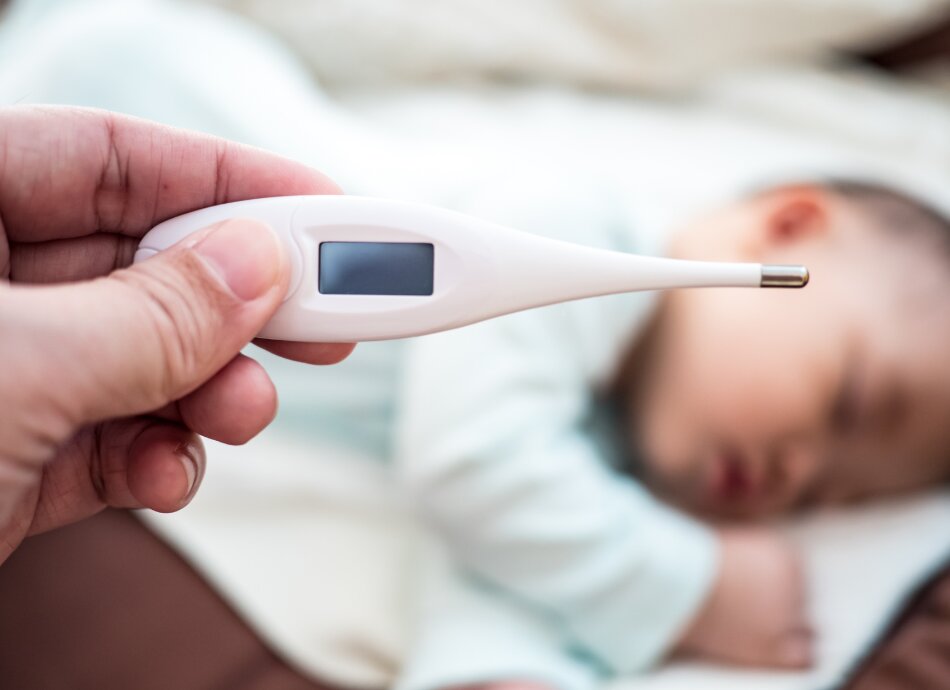
Rotavirus is a viral infection that causes fever, vomiting (being sick) and diarrhoea (runny poo), mostly in babies and young children. It’s very contagious (easily spread) and is the most common cause of dehydration and diarrhoea in babies and young children.
Vaccination against rotavirus is very effective in preventing the infection and the serious complications that it can cause, such as severe dehydration that needs admission to hospital. Read more about the rotavirus vaccine.
Video: Rotavirus
(Immunisation Advisory Centre, NZ, 2017)
Rotavirus is spread from someone who has the virus, such as by contact with the faeces (poo, tūtae) of an infected child or adult. This can happen if you don't wash your hands properly:
- after changing nappies
- after using the toilet
- after touching toys or surfaces that have been in contact with the virus
- before handling food or eating.
People who have a rotavirus infection have a large amount of rotavirus in their poo when they’re sick, and for about a week after they feel better. Rotavirus can survive on your hands for at least 4 hours, typically hours to days, on objects or surfaces and sometimes longer under ideal conditions. Without vaccination, almost all children have been infected with the virus by the time they reach 5 years of age.
Rotavirus disease is most common in infants and young children, but older children and adults can get it too. Tamariki can become dehydrated from diarrhoea and may need to go to hospital, as severe dehydration can be fatal if it’s not treated.
Severe dehydration and need for hospitalisation are most common in children:
- between 3 months and 2 years of age
- who were low birthweight and are still underweight
- with high-risk medical conditions (eg, heart or kidney problems, or diabetes).
Rotavirus increases the risk of bowel obstruction especially in pēpi under the age of 1.
If your child has a rotavirus infection, they usually develop symptoms within 1 to 2 days of catching the virus. The illness lasts from 3 to 8 days and includes:
- a fever that starts suddenly and usually lasts 1–2 days
- vomiting (being sick) that lasts for about 3 to 6 days
- diarrhoea (runny poo) that last for about 5–6 days
- tummy (puku) pain.
Adults can also get a rotavirus infection, but they usually have mild symptoms or no symptoms.
- is less than 6 months of age and has runny poo and/or vomiting – babies can become very dehydrated very quickly
- has lots of diarrhoea (8 to 10 watery poos a day)
- is vomiting so much they can’t keep fluids down
- has severe stomach pains
- has diarrhoea for longer than 10 days
- has signs of dehydration, such as:
- fewer wet nappies or little or no urine (pee) passed in the last 8 hours, or dark and smelly urine
- dry mouth/lips, no tears, sunken eyes, sunken fontanelle in infants
- skin not springing back when pinched
- unusual sleepiness.
Lots of illnesses can cause diarrhoea. Your healthcare provider will often diagnose rotavirus based on symptoms and a physical examination. They may ask for a poo sample to confirm the diagnosis.
Rotavirus isn't treated with antibiotics because it's caused by a virus, not a bacteria.
The best thing to do if your child has rotavirus is to stop them becoming dehydrated by giving them small amount of fluids often, such as a quarter of a cup of clear fluid – water is best – every 15 minutes, or 1 teaspoon (5 mLs) in a syringe every minute. Keep offering your child fluids even if they're vomiting throwing up).
Read more about preventing dehydration in babies and children including the types of fluids you can give your child. You can also ask your healthcare provider or pharmacist about oral rehydration solutions.

Image credit: Canva
If you’re breastfeeding, keep feeding your baby on demand, and if your pēpi is on formula, keep giving them formula feeds.
Tamariki can start eating solids when they feel ready. Plain foods such as toast or dry biscuits are good to start with.
If your child has severe dehydration, they may need to go to hospital to receive intravenous (IV) fluids.
You or your child should not go to school, daycare or work until you’re well and have not had diarrhoea or vomiting for 48 hours (2 days).
Rotavirus is very infectious. It’s easily spread by contact with poo from an infected person. To help stop rotavirus spreading, wash your hands thoroughly with soap and water after changing nappies or using the bathroom, and before preparing and eating food. You should also clean toys and hard surfaces regularly.
Vaccination is the best way to protect against rotavirus
Without vaccination, almost all children will get rotavirus before they’re 5 years of age. Vaccination against rotavirus is very effective. In countries such as Aotearoa New Zealand, vaccination protects about 8 in 10 babies from severe rotavirus infection.
Rotavirus vaccine
The rotavirus vaccine is given as drops that are squirted into your baby’s mouth (oral vaccine).
- In Aotearoa New Zealand, rotavirus vaccination is given free to babies as part of their 6 week and 3-month immunisations. Your pēpi needs 2 doses to be fully protected.
- If you miss these dates, you can catch up, but your baby must receive their first dose before they’re 15 weeks old, and the second dose before they’re 25 weeks old.
- Your baby can't have the rotavirus vaccine after 25 weeks because the risk of serious reactions increases after this age.
Read more about the rotavirus vaccine.
Te mate huaketo puku – rotavirus(external link) Health New Zealand | Te Whatu Ora, NZ
Rotavirus infection(external link) Immunisation Advisory Centre, NZ
Brochures
Rotavirus infection – factsheet(external link) NSW Multicultural Health Communication Service, Australia. Available in other languages(external link) including Arabic, Chinese (traditional), Farsi, Khmer, Korean, Thai, Vietnamese. (Please note that the vaccine type and timing may differ between countries).
Immunise against rotavirus(external link) HealthEd, NZ
The national immunisation schedule(external link) Health New Zealand | Te Whatu Ora, NZ, 2025
Apps
References
- Rotavirus(external link) Immunisation Handbook, NZ
- Immunise against rotavirus(external link) HealthEd, NZ
- Kramer A, Schwebke I, Kampf G. How long do nosocomial pathogens persist on inanimate surfaces? A systematic review(external link) BMC Infect Dis. 2006;6:130
- Crawford SE, Ramani S, Tate E, et al. Rotavirus infection(external link) Nature Reviews Disease Primers 2017;3:Article 17083
- Gastroenteritis in children(external link) Auckland Regional HealthPathways, NZ, 2022
Rotavirus(external link) Immunisation Advisory Centre, NZ
Immunisation handbook – rotavirus(external link) Health New Zealand | Te Whatu Ora, NZ
How long does rotavirus last?
The symptoms for children can last 3 to 8 days. Adults may have the virus but not have any symptoms.
What are the rotavirus symptoms?
The symptoms can include a high temperature (fever), a sore tummy, feeling or being sick, and diarrhoea (runny poo).
Can rotavirus come back?
Yes, it's possible to be infected again, even if you've been vaccinated. However, the first infection usually has the worst symptoms and children who've been vaccinated are less likely to get sick from rotavirus.
What are the rotavirus vaccine side effects?
Not everyone gets side effects, but the more common ones are your baby being restless and irritable. Some babies have mild diarrhoea (runny poo), vomiting or tummy pain. These side effects are usually mild and settle in a few days. Very rarely, babies may get a blocked bowel (intussusception). However, the risk of serious illness from rotavirus infection is thought to be much higher than the vaccine-related risk of intussusception. Read more about the rotavirus vaccine.
Brochures

Ministry of Health, NZ, 2017
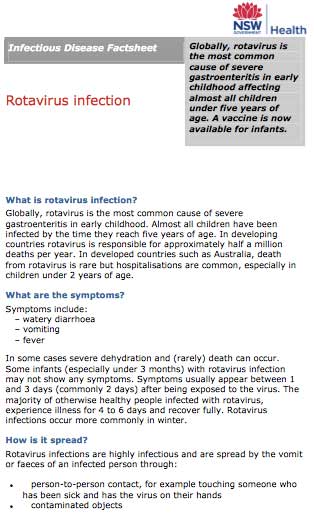
NSW Multicultural Health Communication Service, Australia
Arabic, Chinese (traditional), English, Farsi, Khmer, Korean, Thai, VietnameseMore languages
Credits: Healthify editorial team. Healthify is brought to you by Health Navigator Charitable Trust.
Reviewed by: Dr Grace Lee, FRNZCGP and Clinical Educator
Last reviewed:


